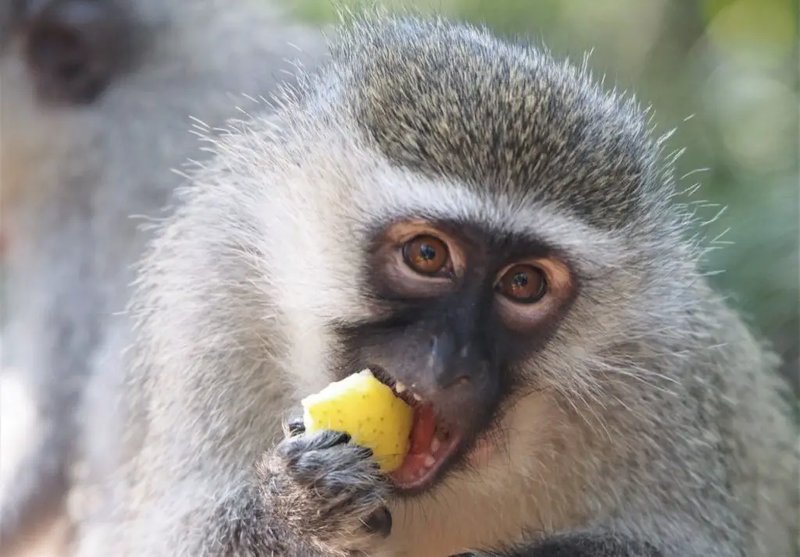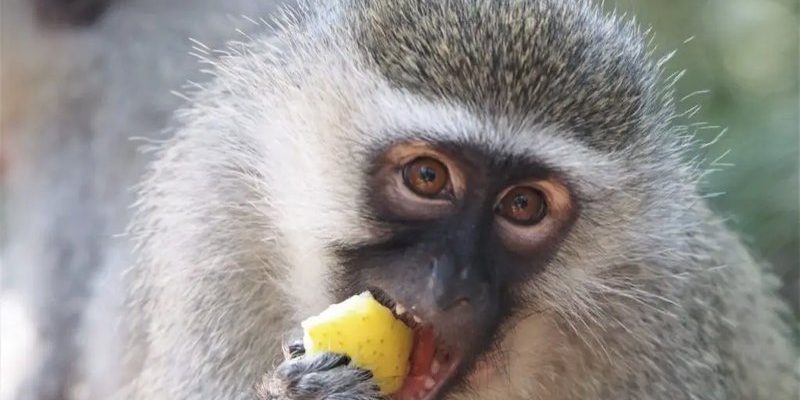
These monkeys, native to Southern Africa, have developed diverse diets and hunting tactics that not only keep them nourished but also showcase their adaptability. Whether they’re munching on fruits or snatching insects, their eating habits are as dynamic as their environments. Let’s dive into the world of the vervet monkey and explore their dietary preferences and hunting methods.
Understanding the Vervet Monkey’s Diet
Vervet monkeys have a varied diet that reflects their resourcefulness. They are primarily herbivores, meaning they mostly eat plant-based foods. However, they aren’t shy about adding some protein to their meals by munching on insects and small animals. This flexible diet allows them to thrive in different environments, from savannahs to forests.
What exactly do these monkeys eat? Here’s a quick rundown:
- Fruits: Vervet monkeys love fruits like berries, figs, and bananas. These sweet treats provide them with essential sugars and vitamins.
- Leaves and Flowers: They also munch on leaves and flowers, which offer fibers and nutrients. Think of it as their version of a salad!
- Seeds and Nuts: Seeds and nuts are like snacks for vervet monkeys; they provide healthy fats and protein, perfect for energy.
- Insects: When they’re in the mood for something crunchy, they hunt insects like crickets and grasshoppers, which give them that extra protein boost.
Their diet changes with the seasons. In the rainy season, fruits are plentiful, while dry seasons may require a more foraged approach. You might be wondering how they balance their food intake. Well, they often forage in groups, sharing information about where to find food and helping each other out.
Hunting Strategies: A Team Effort
While vervet monkeys primarily graze on plants, they have developed unique hunting strategies to catch insects and small animals. They’re not just about eating what’s available; these clever creatures know how to work together to get their meals.
One common hunting technique they use is creating a watch system. When foraging, one or more monkeys will keep lookout while others search for food on the ground or in the trees. If they see a predator, they can quickly alert their friends. This teamwork is essential for their survival—like having a buddy system when you’re exploring a new place!
Here’s how their hunting strategy plays out:
- Cooperative Hunting: They often hunt in groups, increasing their chances of finding food. When one monkey discovers a food source, they alert the others to join in.
- Stalking and Ambushing: For insects, vervet monkeys will stalk their prey quietly and then pounce. It’s a bit like playing hide and seek, but the stakes are a snack!
- Using Tools: In some cases, they might use sticks or leaves to extract insects from hard-to-reach places. It’s smart, right? Think of it as their version of using a fork!
By combining intelligence with coordination, vervet monkeys showcase how effective teamwork can be for hunting.
Eating Habits Throughout the Seasons
The vervet monkey’s diet isn’t just seasonal; it’s also highly opportunistic. Different seasons bring different food sources, and these monkeys have adapted their eating habits accordingly.
In the wet season, when fruits and greens are abundant, you’ll find them munching on the tastiest offerings in the trees. It’s like a buffet! They can eat a lot of calories during this time, storing energy for when food might be scarcer.
During the dry season, however, things change. The fruits and leaves are less plentiful, so vervet monkeys must adjust. Here’s how they cope:
- Foraging in New Areas: They might travel further to find food or explore new areas where food is available.
- Eating Insects More: With fewer fruits around, they shift to hunting insects, which are high in protein and easier to find.
- Storing Food: Sometimes, they’ll hide food items to save for later, much like you might save leftovers in your fridge.
This ability to adapt to changing conditions not only helps them survive but also keeps their social dynamics interesting. Knowing when to forage where is part of their community knowledge.
Social Dynamics and Food Sharing
Social structure plays a significant role in the diet and hunting strategies of vervet monkeys. They live in groups called troops, typically made up of 10 to 50 monkeys. The way they share food is fascinating and essential for group cohesion.
In these troops, food sharing isn’t just about generosity; it can enhance relationships between individual monkeys. For instance, a dominant monkey might eat first, but they often allow others to feed from the same source afterward. This creates bonds and maintains peace within the group.
Here’s how food sharing often unfolds:
- Trade and Reciprocity: Monkeys will share food with other monkeys in return for grooming or other favors. It’s a constant give-and-take that keeps friendships strong.
- Learning Opportunities: Young monkeys learn where to find food by observing older members of the troop. It’s like passing down family recipes!
- Preventing Conflict: By sharing food, conflicts over resources are minimized, helping maintain harmony within the group.
This is more than just eating; it’s about building a social network that ensures survival.
The Role of Habitat in Their Diet
The habitat where vervet monkeys live greatly influences their diet. Commonly found in savannahs, woodlands, and even near human settlements, their environment plays a crucial role in what they eat.
In areas close to human habitation, vervet monkeys can easily access crops and gardens, making them somewhat of a nuisance to farmers. They have learned to adapt their diet based on what humans grow, often raiding farms and orchards for an easy meal.
Here’s how their habitat impacts their dietary choices:
- Food Variety: Monkeys living in areas with diverse plant life tend to have a more varied diet compared to those in more barren landscapes.
- Coping with Human Activity: In urban areas, they’ve adapted to eating discarded food or fruits from backyards, showcasing their resilience.
- Access to Water: Proximity to water sources also affects their diet. Areas with streams or lakes provide more options for foraging.
This adaptability is impressive and shows how vervet monkeys can thrive despite changes in their environment.
Conservation and Future Challenges
As fascinating as vervet monkeys are, they face challenges that threaten their habitat and food sources. Urbanization, deforestation, and climate change all impact their living conditions and diet, which can lead to conflicts with humans.
Conservation efforts are crucial to ensure these clever monkeys continue to thrive. Education plays a vital role. By promoting understanding and coexistence between vervet monkeys and humans, we can help protect their habitats and encourage sustainable practices.
Challenges they face include:
- Habitat Loss: As more land is cleared for agriculture or development, vervet monkeys lose access to their natural food sources.
- Human-Wildlife Conflict: Farmers may see them as pests, leading to the culling of monkey populations.
- Climate Change: Changes in weather patterns can affect food growth, putting pressure on their dietary habits.
Investing in conservation and education is essential to preserve these remarkable animals and their complex diets.
In summary, the vervet monkey’s diet and hunting strategies offer a glimpse into their intelligent and adaptive nature. By understanding what they eat and how they share food, we can appreciate their role in the ecosystem and the challenges they face. Truly, these little monkeys teach us a lot about survival, teamwork, and resilience in a changing world.

